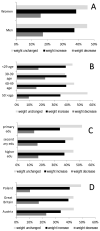Dietary Habits before and during the COVID-19 Epidemic in Selected European Countries
- PMID: 34065655
- PMCID: PMC8156782
- DOI: 10.3390/nu13051690
Dietary Habits before and during the COVID-19 Epidemic in Selected European Countries
Abstract
During the so-called "second wave of the pandemic" in Europe, the authors conducted a cross-sectional online survey that aimed to examine changes in dietary habits and associated practices, as well as physical activity during the COVID-19 pandemic and before the onset of lockdowns in three European countries: Poland, Austria and the United Kingdom.
Methods: The online observational study, both prospective and retrospective, conducted with the use of social media for the distribution of an anonymous online questionnaire, was completed from 1 October to 30 October 2020, during the second wave of the pandemic in Europe. The study encompassed a total of 1071 adults from Poland (n = 407), Austria (n = 353) and the United Kingdom (n = 311).
Results: The results of this study indicate that the COVID-19 confinement period influenced eating behavior and the level of physical activity in a group of adult residents of Poland, Austria and the United Kingdom. The general shopping frequency decreased, regardless of the place and manner. However, there was an increased interest in online grocery shopping. The resulting data revealed an increased frequency of the daily consumption of food products such as dairy, grains, fats, vegetables and sweets (p < 0.05). A rise in the frequency of purchasing frozen goods and food with long shelf life has also been observed. The changed workplace and working conditions or unemployment probably affected a perceptible rise in alcohol consumption (p = 0.02). In turn, physical activity levels markedly decreased, which reflected the body mass changes.
Conclusion: The dietary habits in the studied countries have changed as a result of the pandemic situation. They contribute to the aggravation of the problem of excess body weight and its health consequences.
Keywords: COVID-19 pandemic; dietary habits; obesity; physical activity.
Conflict of interest statement
The authors declare no conflict of interest.
Figures



References
Publication types
MeSH terms
LinkOut - more resources
Full Text Sources
Medical

